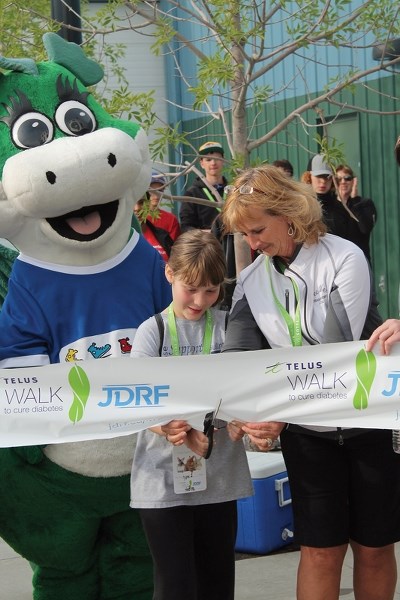Over 100 people turned out to the Rotary Spirit Centre June 16 to help raise money for research into Type 1 diabetes.
The event was part of JDRF’s Walk to Cure Diabetes that brings over 45,000 people across 70 cities and towns across the country.
The walkers were there to help people like 17-year-old Ryley Patriquin, who has been living with Type 1 diabetes since she was 10.
“It’s a lot of work to take care of,” she said. “It never goes away, always having to worry about it and be prepared.”
Type 1 diabetes is a disease where the pancreas, an organ responsible for makes insulin, stops working. There is no known cure and it’s not clear as to what causes it.
Life for someone with the disease becomes a balancing act. Because their pancreas isn’t making insulin they are constantly required to check their blood sugar levels and top up with extra insulin.
It’s process that requires pricking a finger so some blood can be tested in a small device and sometimes it needs to be done eight to 10 times a day.
Insulin is delivered a number of ways, including via injection or a pump that’s permanently attached to the patient.
“I’m on an insulin pump so I have a lot more freedom,” Patriquin said. “But I just have to be careful of what my blood sugars are and count carbs when I’m eating.”
Participants followed the Rotary Trail over five kilometres after a barbeque, activities and ceremony.
Patriquin said she appreciates the effort the fundraisers go to and the eventual aim, finding a cure for Type 1 diabetes, would change her life.
“It would mean I would have so much more freedom and I wouldn’t have to plan ahead and always make sure I have everything with me. I could be a lot more spontaneous,” she said.
The money raised goes to three main areas of research, the treatment and prevention of and an eventual cure for Type 1 diabetes.
The JDRF estimates that by the year 2020 the disease will cost Canadian’s $16.9 billion.
Barb Armstrong, a JDRF volunteer ambassador, says she helps the charity because of the money raised goes to finding a cure.
“I was drawn to the JDRF because of the amount of money that goes direct to research,” she said.
That research is starting to bare fruit on projects like the Edmonton Protocol, which involves the transplantation of pancreatic cells.
As well, in 2006, JDRF launched the Artificial Pancreas Project (APP) to accelerate the development of a commercially-viable artificial pancreas as a system to ultimately mimic the biological function of the pancreas for patients with type 1 diabetes.
“People have actually left the clinical setting and are out in normal, regular living spaces with an artificial pancreas,” Armstrong said.
“The artificial pancreas actually does the thinking for you. With the pump you still have to calculate your carbohydrates, but the artificial pancreas will do that all for you. So it’s a closed-loop system.”



